On Tumblr, artist Ronald Wimberly wrote a very cogent post on why artists should get paid to do sample pages: A quick preface: Yesterday a friend of mine told me the story of how she was scouted by DC Comics to participate in their “talent” workshop. My colleague, who worked as a professional for 7 years […]
Add a CommentViewing: Blog Posts Tagged with: Working for a Living, Most Recent at Top [Help]
Results 1 - 25 of 71
Blog: PW -The Beat (Login to Add to MyJacketFlap)
JacketFlap tags: Art, Working for a Living, Add a tag
Blog: PW -The Beat (Login to Add to MyJacketFlap)
JacketFlap tags: Working for a Living, maia kobabe, school loans, Cartoonists, Add a tag
Maia Kobabe is a very talented up and coming cartoonist as the above page from her Tom O’Bedlam adaptation shows. (disclosure: she is also a reviewer for me at Publishers Weekly.) Recently she wrote a very frank tumblr post in response to a question about whether to enter the California College of the Arts MFA […]
Blog: PW -The Beat (Login to Add to MyJacketFlap)
JacketFlap tags: Working for a Living, Fair Page Rates, Cartoonists, Add a tag
I’m late in commenting on the industry rates survey posted by Fair Page Rates an anonymous industry watchdog. But along with the sales softening I was writing about earlier, it’s part of an industry infrastructure that isn’t as strong as it could be. The survey quotes a lot of page rates based on a survey […]
Blog: PW -The Beat (Login to Add to MyJacketFlap)
JacketFlap tags: Commissions, Indie Comics, Working for a Living, Kelly Williams, Metaphase, Interviews, Comics, Add a tag
 Welcome to MATT CHATS, a weekly interview series that goes live every Tuesday conducted between myself and a creator and/or player in the comic book industry, diving into subjects not broached by other comic news outlets. One of the artists most deserving of work from the Big Two or even the “Big Five” is, in my opinion, […]
Welcome to MATT CHATS, a weekly interview series that goes live every Tuesday conducted between myself and a creator and/or player in the comic book industry, diving into subjects not broached by other comic news outlets. One of the artists most deserving of work from the Big Two or even the “Big Five” is, in my opinion, […]
Blog: PW -The Beat (Login to Add to MyJacketFlap)
JacketFlap tags: Meta, new years day, Working for a Living, andrew wk, Add a tag
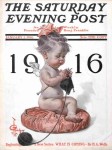 Happy New Year, faithful Beat readers. Hoping it’s a happy and healthy one for all. 2015 was a challenging year for many of us with many changes blowing through the world of comics, but, in the words of Omega the Unknown, “to resist change is to embrace despair.” Of course none of this would have […]
Happy New Year, faithful Beat readers. Hoping it’s a happy and healthy one for all. 2015 was a challenging year for many of us with many changes blowing through the world of comics, but, in the words of Omega the Unknown, “to resist change is to embrace despair.” Of course none of this would have […]
Blog: PW -The Beat (Login to Add to MyJacketFlap)
JacketFlap tags: how the sausage is made, Process, Meta, Comics Media, comics journalism, Working for a Living, Top News, Add a tag
For the past few days there has been a kerfuffle in the extremely high profile, glamourous and profitable world of comics journalism. Rather than comment on this hot mess, I'm going to talk about why it happened. And what we an do to improve things.
Blog: PW -The Beat (Login to Add to MyJacketFlap)
JacketFlap tags: Kris Mukai, Cartoons, Working for a Living, Top News, Add a tag
In re the last piece, here’s a direct link to my first piece for Slate in which I investigate the comics/cartoon connection with quotes from Rebeca Sugar, Kevin Lee, Annie Koyama, Sam Alden and Ryan Sands. As a longtime reporter on the comics world, I was a bit surprised when cable animation started scooping up […]
Blog: PW -The Beat (Login to Add to MyJacketFlap)
JacketFlap tags: Working for a Living, Top News, Jimmie Robinson, Cartoonists, Add a tag
[Jimmie Robinson is the creator of The Empty, Five Weapons, Bomb Queen, Amanda and Gunn, Avigon and Evil & Malice, among many other comics. As the below will reveal, he’s a lifer for comics, as well as a creator who has stuck with creating his own vision — including kids comics, women of color as […]
Blog: PW -The Beat (Login to Add to MyJacketFlap)
JacketFlap tags: News, Top Cow, Working for a Living, Top News, Add a tag
UPDATED WITH CAVEAT: Alex De Campi has pointed out that show ever has put this together used her slide on page rates without crediting her, which is a little uncool for a page that purports to have creators rights at heart — OTOH maybe they didn’t want any specific names attached to the project? There’s […]
Blog: PW -The Beat (Login to Add to MyJacketFlap)
JacketFlap tags: Working for a Living, Top News, Comics Media, Add a tag
Time to get meta again! The article The Awl by Noah Davis about rising pay rates for online writing gave hope to millions: Many newer outlets offer fifty cents per word or more—sites like The Verge might pay a dollar per word—as do established publications, including New York‘s blog network and The Guardian. “You can […]
Blog: PW -The Beat (Login to Add to MyJacketFlap)
JacketFlap tags: tom brady, Working for a Living, Top News, jane rosenberg, Art, Add a tag
As we all know, paying jobs for artists can be in short supply. One of the more obscure but potentially full-time gigs is courtroom sketch artist—although cameras are increasingly allowed in courtrooms, sometimes a sketch is still the only way to bring the drama to the public. The cautionary tale of Jane Rosenberg would remain […]
Blog: PW -The Beat (Login to Add to MyJacketFlap)
JacketFlap tags: Cartoonists, steve rude, Working for a Living, Top News, Add a tag
Legendary artist Steve Rude has an open submission form on his website for a colorist to color new Nexus and Moth stories.
Blog: PW -The Beat (Login to Add to MyJacketFlap)
JacketFlap tags: Working for a Living, Top News, Todd Allen, indie comcis rates, making comics, page rates in comics, Retailing & Marketing, Add a tag
Over the last year or so, there’s been an increasing amount of talk in creator circles about the low page rates being given out by independent publishers for some of the smaller books. The last two or three years, publishers have been putting out a lot more titles than they used to and a lot […]
Blog: PW -The Beat (Login to Add to MyJacketFlap)
JacketFlap tags: Retailing & Marketing, promotion, social media, Working for a Living, Top News, blerdgurl, Add a tag
We’ve quoted Blerdgurl (formerly Derpygurl) before on promoting at cons, and she has a new post out called 10 Ways to Promote Your Project for Free With Bloggers, Journalists and Podcasters with the subtext of not being annoying. It’s a pretty clear step by step examination of how to get known in the social media […]
Blog: PW -The Beat (Login to Add to MyJacketFlap)
JacketFlap tags: Cartoonists, mike lynch, Working for a Living, Top News, Faith Erin Hicks, Add a tag
Short answer: no. Faith Erin Hicks has a far more informative and entertaining longer version, which includes anecdotes and concrete evidence of how she broke in while living in relatively remote, Halifax, NS. A few years ago I was at a dinner with a bunch of people I knew casually. They all worked in the […]
Blog: PW -The Beat (Login to Add to MyJacketFlap)
JacketFlap tags: nickelodeon, SPX, working for a living, CAFs, Cartoons, Add a tag
While the chance for SPX exhibitors to pitch cartoon ideas to Nickelodeon as announced yesterday sounds like a good opportunity, there was quite a bit of controversy about it on social, as seen in these tweets. Click on the Gillman and Gran links to go to much longer discussions, but the basic objection is that SPX is a small press show that celebrates the joy of small press comics, and formalizing the participation of a major cartoon network/corporate brand at the show goes against that philosophy.
Blog: PW -The Beat (Login to Add to MyJacketFlap)
JacketFlap tags: Working for a Living, Top News, alex fellows, Webcomics, Add a tag
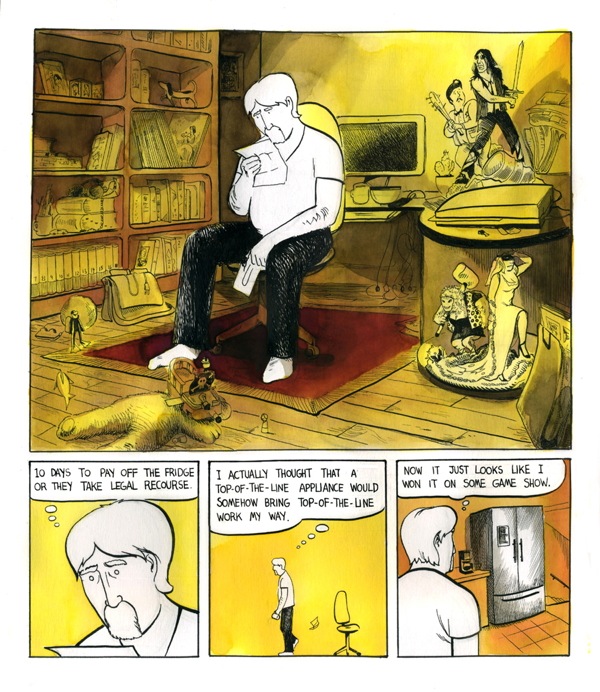
Here’s a comic that sums up all the money stuff we’ve been talking about for the last few weeks. The unnamed cartoonist in Alex Fellows’ ICE CREAM has just purchased a fancy refrigerator he can’t really afford. I think most of us will empathize with the financial soul searching, credit card juggling and marital discord that follows.
I could pull any number of panels in this comic but here’s just one.
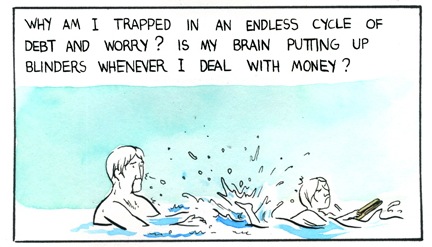
Ouch.
I wasn’t familiar with Fellows work, but he won a Xeric in 2002 for Blank Slate and a Doug Wright Award for Best Emerging Talent in 2011 for his comic, Spain and Morocco. You can see more of his work here. I’ll definitely be following Ice Cream!
Blog: PW -The Beat (Login to Add to MyJacketFlap)
JacketFlap tags: Toys, Manga, Yen Press, Working for a Living, Top News, Kiyohiko Azuma<, Kotobukiya, yotsuba&!, Add a tag
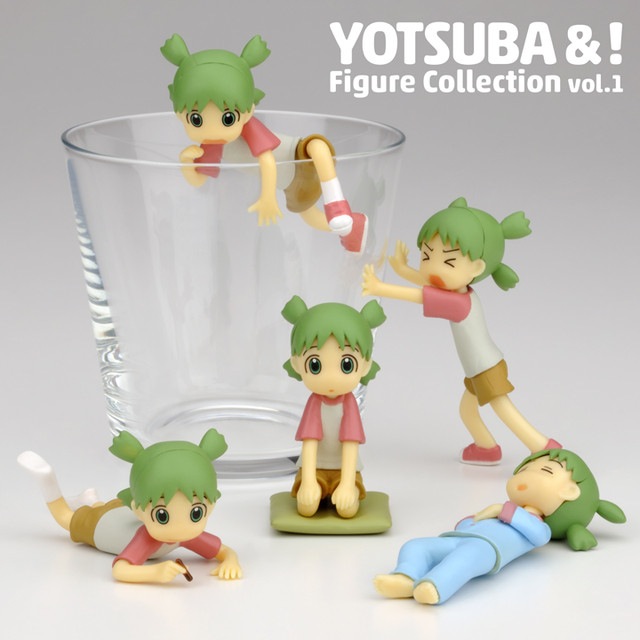
In my post on making money making comics, Tyler James had an interesting comment about how merchandising has to be part of a creator’s business plan:
Any book that can raise $90K in profits on floppy comic sales alone should be able to ALSO raise at least half that much in related merchandise designed around that property.
I see so few “mainstream” creator-owned creators taking advantage of the significant investment they’re making in building properties by providing their superfans additional opportunities to throw money at them on higher margin items (prints, t-shirts, artist editions, posters, plushies, etc.)
(There are, of course, some exceptions to this… Case in point, the CHEW guys teaming up with our friends at Skelton Crew — https://www.kickstarter.com/projects/49910827/tony-chu-mini-bust?ref=nav_search )
Successful webcomic creators never had that problem, and realized years ago that the comic itself is only one piece of the puzzle for building a successful career. Multiple streams of income and revenue sources are a must for most creators in 2015… gotta think beyond the page rate and the $3.50 floppy.
Reading this reminded me of my trip to the Page and Panel TCAF store located in the Toronto Reference Library. This is the nicest comics “gift shop” I’ve ever been to in North America, inspired by the great stores of France, with a carefully curated selection of comics and very appropriate merchandise, from a Kate Beaton tea towel to Moyocco Anno mugs. Topatoco merchandise based on popular webcomics was indeed well represented and seeing goods that moved on beyond the usual superhero and Star Wars lines was inspiring.
All of which is a prelude to saying, I WANT THESE YOTSUBA&! FIGURES!!! These are tiny 5cm high figures made by Kotobukiya. In case you never read it Yotsuba&! (pronounced, as I believe, Yot-su-ba-sa) is a manga by Kiyohiko Azuma, currently published by Yen Press, about a little alien girl who changes a bachelors life with her sunny attitude. It sounds hackneyed in the manner of any number of sitcoms (Small Wonder, anything starring John Stamos) and manga (Dr. Slump) but it’s actually warm, winsome, charming and sweet natured as all get out. It’s almost always on any top 10 Manga for Beginners list with good reason. BUY IT!
That’s part of the reason these figures are so sweet and endearing. I have nothing against Darth Vader, Superman and Iron Man, but they are everywhere and a lot of the merch is tacky. There are a lot of beautifully designed comics characters out there that would look great on a mug or a minifig or a tea towel, and as Adventure Time shows, people will buy cute things. It’s okay to take the Bill Watterson zero tolerance line on this, but I do agree with Tyler James: a well thought out, appropriate merchandising line is a powerful accompaniment to any business plan for creators and small publishers.
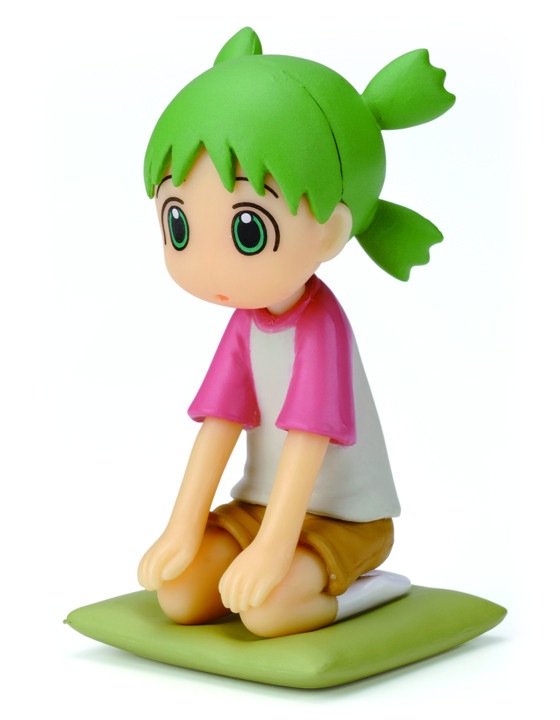
Blog: PW -The Beat (Login to Add to MyJacketFlap)
JacketFlap tags: Cartoonists, comics economics, Working for a Living, Top News, Kieron Gillen, the wicked and the divine, Add a tag
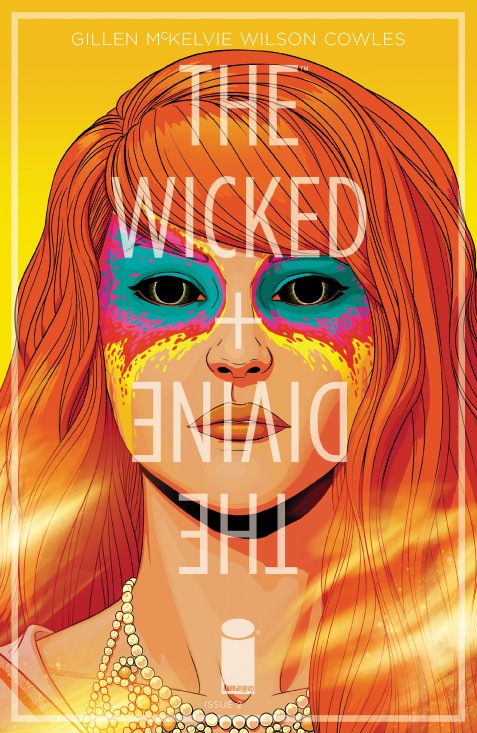
After yesterday’s gloom parade over the economics of comics, and the small number of people who seem to be making a good wage from making them, writer Kieron Gillen delivered another set of metrics that was far more cheerful. He wrote it in response to a website’s concern trolling over sales of The Wicked + The Divine—a much loved series which Gillen writes and Image publishes—falling to the dangerous level of 22,519 copies, a level so low that the writer wondered if this was the end of the book…before admitting that it probably wasn’t.
As Gillen points out, numbers for a creator owned Image book are a lot different than for a Marvel or DC book, where such a number would be in the danger zone. Actually, that number would indicate that Gillen and his collaborator Jamie McKelvie could possibly buy me a beer at some point.
I’ll give you some really basic rule of thumbs for indie comic commentary:
Anything selling stably over 10k in single issues is a cause for celebration and joy. The creators are almost certainly extremely happy.
If you’re selling over (ooh) 12k, you’re probably making more than either of the big two would pay you, unless you’re one of the very biggest names.
If you’re selling anything near 20k, you probably have to buy drinks for your friends.
And in a real way, if Phonogram settled around 6k back in 2006, I suspect Jamie and I would have settled into doing it for another 40 or 50 issues.
There’s all manner of exceptions to the above, but if you look at the charts and bear that in mind, you’ll be closer to how the industry looks at those numbers.
None of the above includes digital sales.
As he goes on to enumerate, if you’re not including sales of TRADE PAPERBACK COLLECTIONS in the indie equation you are missing a huge income source:
None of the above include trades. You throw trades in, and you change everything entirely. A cursory look at hit indie comic numbers reveals that their trades sell much more than Marvel/DC main universe trades, with a few exceptions (There’s a reason why Matt and David’s Hawkeye was such a big thing, and it wasn’t its monthly sales). Let’s bold another sentence.
You cannot do an industry commentary column on indie books without including the impact of trades.
Jim Zub wrote a lot about all this a while ago, and updated it with numbers similar to Gillen’s. At the breakeven-ish point for an Image comics (let’s say ~5000 copes) the creative team gets 25% of the profits, which on a $3.99 would be about a buck, the ballpark I’ve often heard for Image books. it’s only that, a ballpark, but it does give you some idea. A book selling $10k a month is making money.
And how many Image books are selling that? Well, ICv2’s numbers just came out so let’s take a look!
| WALKING DEAD #141 (MR) | $2.99 | IMA | 68,931 |
| SAGA #28 (MR) | $2.99 | IMA | 55,239 |
| INJECTION #1 (MR) | $2.99 | IMA | 41,648 |
| WYTCHES #6 (MR) | $3.99 | IMA | 34,259 |
| DESCENDER #3 (MR) | $2.99 | IMA | 29,717 |
| MYTHIC #1 [*] | $1.99 | IMA | 29,361 |
| OUTCAST BY KIRKMAN & AZACETA #9 (MR) | $2.99 | IMA | 28,961 |
| CHRONONAUTS #3 (MR) | $3.50 | IMA | 26,605 |
| JUPITERS CIRCLE #2 (MR) | $3.50 | IMA | 24,499 |
| EAST OF WEST #19 | $3.50 | IMA | 22,482 |
| FADE OUT #6 (MR) | $3.50 | IMA | 20,678 |
| WICKED & DIVINE #10 (MR) | $3.50 | IMA | 20,562 |
| SONS OF THE DEVIL #1 (MR) [*] | $2.99 | IMA | 19,392 |
| BLACK SCIENCE #14 (MR) | $3.50 | IMA | 17,090 |
| KAPTARA #2 | $3.50 | IMA | 16,635 |
| SPAWN #252 (MR) | $2.99 | IMA | 15,904 |
| TREES #9 (MR) | $2.99 | IMA | 15,821 |
| RUNLOVEKILL #2 (MR) | $2.99 | IMA | 15,669 |
| SAVIOR #2 | $2.99 | IMA | 13,625 |
| INVINCIBLE #120 | $2.99 | IMA | 13,191 |
| MANTLE #1 (MR) | $3.99 | IMA | 13,076 |
| BIRTHRIGHT #7 | $2.99 | IMA | 12,561 |
| ODYC #5 (MR) | $3.99 | IMA | 12,557 |
| DEADLY CLASS #13 (MR) | $3.50 | IMA | 12,299 |
| MATERIAL #1 (MR) | $3.50 | IMA | 11,708 |
| NAILBITER #12 (MR) | $2.99 | IMA | 10,688 |
| VALHALLA MAD #1 | $3.50 | IMA | 9,952 |
Answer: 27. Okay now you know who can buy you a drink!
On a more serious note, most of the books in the above list sell for $2.99 or $3.50, so there is less to split between writer and artist, letters, colorists and designers have to be paid, etc etc. And also, the ICV2 estimates are just that…estimates, and consistently about 10% low, although there can be other discrepancies, so you shouldn’t take any of these numebrs as gospel, especially the trade sales—total sales are VERY different from the ICv2 numbers, which don’t take bookstores, some online sales, digital, library, book fair or many other numbers into account.
And were still not talking an insane amount of money. Let’s say a book sells 10,000 copies and makes $7500 for the creators. That’s $90,000 a year to be split among the team, so you need another income course for a vacation or retirement.
But still, you CAN make money making comics!!! I suppose I shouldn’t encourage people after yesterday’s dismal reality check; but I think my being in a band analogy stands. It’s better to have made comics or music than never to have tried at all. Most people in every creative endeavor are never going to reach the highest highs, and comics are no exception.
What is concerning is, as I’ve often pointed out, the comics bottom line is a lot lower than in other vocations. There was a pretty lively Twitter conversation yesterday about my piece and especially David Harper’s survey; I’m not sure I have the storify skills to capture it but it came down to people accepting low rates because they are so eager to get into comics and undercutting other creators.
And also, there’s a fairly narrow window in which to make decent money when you do get there. Scott Snyder may make more from Wytches than he does from Batman, but Image is only one publisher, and as hot as they are, they can’t publish everything. (Although we’ll see after this year’s Image Expo.) Image is the best game in town but it has finite resources. Marvel and DC offer good page rates—although Marvel lowered theirs for all but their top creators last year—but the competition is fierce, the politics are daunting and getting established takes a lot of hard work.
Nobody promised you fame and fortune when you got out of cartooning school, but you should have some path forward that doesn’t involve only three publishers or sleeping three hours a night.We need more options, more competition among publishers, and more safety for creators to make decisions that improve their page rates.
How?
More on that later but in the meantime, what do YOU think?
Blog: PW -The Beat (Login to Add to MyJacketFlap)
JacketFlap tags: Cartoonists, Working for a Living, Top News, alex de campi, Janelle Asselin, david harper, brian churilla, comics wages, sktchd, Add a tag
Being in comics is great, it’s a golden era, new readers, yadda yadda. But this golden era is mostly the product of people slaving away at drawing boards and computers for long hours and a meagre living. And now here are some numbers to prove it. David Harper, formerly of Multiversity, has just launched his own site, called Sktchd and he’s continuing the valuable longform pieces that were the best part of the old site. Recently he sent out a survey for artists to explain who they are and what they do and 186 of them responded. You’ll want to read the whole thing as it has some metrics on gender, income, publishers and much more. (David lives in Alaska and they have free time there, I guess.) Broken down with a ton of charts and graphs it’s a non-statistically valid snapshot, but the numbers are sobering. Let’s just get to the bottom line here., since that’s what you came for.
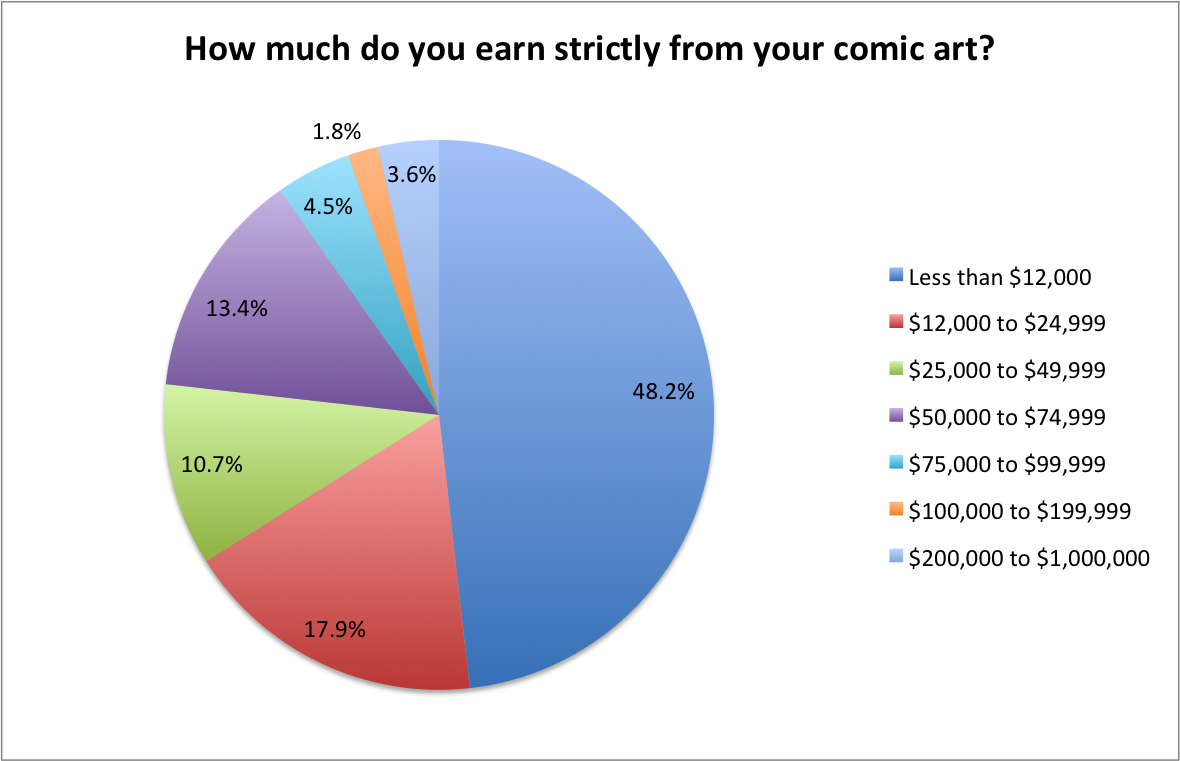
Forget getting rich though. Can artists even make enough to get by off their art? Mostly, the answer is no, they can’t. Almost 60 percent of artists who responded shared they can’t make a living off their work. What that means is many artists live interesting double lives. While many mentioned that they did freelance illustration, animation, advertising work, storyboards or other art related jobs to supplement their income, there were others who worked in factories, as bartenders, or even in one special case, lived off earnings as a figure drawing model and a tarot card reader.
Others bring in income from alternative sources, including working in a shared income household with a spouse and leveraging Patreon and other crowd-sourcing outfits to help them get by. Artists may not be making the big bucks, but they are a resilient and resourceful group.
There’s much more to chew on, including satisfaction with publishers, with DC?Vertigo getting high marks and Boom and Dynamite getting low marks, formats, art methods and so much more. Like I said read the whole thing, quote it, make it a part of your life.
In a subsequent post, Harper goes even further into the maw of the cyclone and breaks things down by gender. And it looks bad.
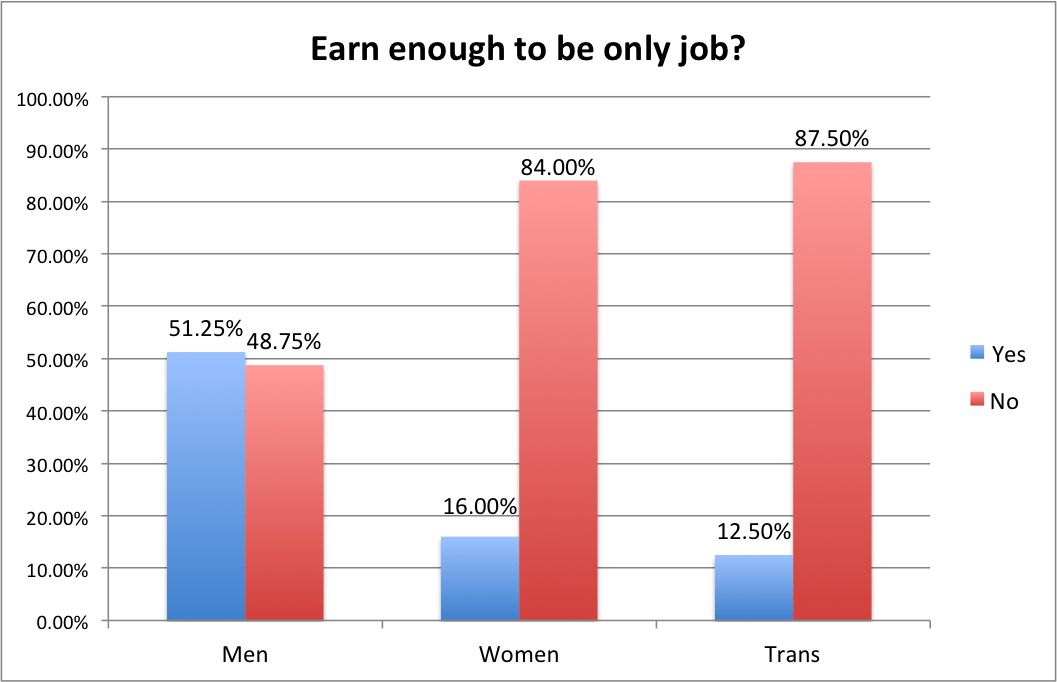
While this seems to make the case that cis men are generally paid more for comics than non cis males, Harper points out that more women, trans and non-binary creators just started their careers, and more work outside the relatively lucrative field of monthly floppies:
When you take the data for the comics creators work on and cross-reference it with the variables based around money, that’s when you see an additional correlation. More than half of floppy artists make enough money for that to be their only job. It’s the only format where that is the case, with over 80 percent of webcomic creators being unable to make a living off their work. Additionally, the majority of graphic novel and webcomic artists who responded make less than $12,000 a year off their work, and as a whole make less money than those who work on floppy comics.
As shown above, while men work more frequently in floppies, women, trans*, non-binary and agender artists most often work in graphic novels and webcomics, per the survey. Because of that additional correlation, the question becomes a chicken and the egg one: were the non cis male artists who responded more poorly compensated because of their gender or because of the format they work in?
Or perhaps because most floppy decision makers are cis males?
Lest ye despair at all this, it’s worth pointing out that the fast growing field of kids and YA graphic novels is dominated by women—and there are a few trans creators doing well there too. This is far from being a universal money spout, but it’s an alternative.
I’ve written here a few times about how page rates in comics have not gone up except for the tippity top guys, and a few other recent posts have driven that home. Janelle Asselin recently pointed out that today’s page rates are about where they were in a 1978 creators bill of rights. Thats unadjusted for inflation.
Adjusted for inflation, those rates today would be:
Artists: $1080
Writers: $360
Letterers: $144
Colorists: $252It’s not an overstatement to say that these rates, adjusted for inflation, dwarf most creators’ rates today. There are maybe a few very, very top level creators who make similar or higher rates, but primarily only writers and artists working at top-tier publishers. In fact, there are a lot of creators in comics today who don’t even make as much as the 1978 rates quoted without adjusting for inflation. And there are a lot of creators in comics who can’t afford to make comics full time because they don’t make enough doing so.
At Special Edition a few days ago, Alex De Campi put together some numbers on page rates:
WFH/PAGE MAINSTREAM INDIE Script $80-100 $25-50 Covers $600-700 $200-500 Line art $200-300 $100-250 Colour art $120-150 $35-100 Letters $20-25 $10-20
These rates are, shockingly, about where they were when I edited comics 15 years ago. The 1978 document called for a lettering rate of $40 a page, so there one thing that has become significantly devalued with time.
Finally, here’s another much linked to piece, from artist Brian Churilla, creator of Hellbreak and The Secret History of DB Cooper and currently Boom’s Big Trouble in Little China comic. Sounds like a guy who works steadily and makes a living at it, right? Not so fast. Basically Churilla backs up Harpers stats on living well below a “middle class” level, as if that even existed any more. Even more dismal is his time breakdown:
So. Here’s the schedule I keep:
7:00am – Wake up, feed the kids and get them ready for school.
8:30 – Take the kids to school
9:00-9:30am – Start work
12:30pm Pick up kid #1
3:30pm: Pick up kid #2
4:00-9:00pm – Family time.
9:00pm-3:00am Work
3:00am Sleep.
Yep. That’s four hours of sleep per day, best-case scenario. Weekends too. Due to the sleep deprivation, I feel like absolute garbage all the time. Depression, anxiety, nausea, fatigue, weight gain, compromised cognitive abilities, even hallucinations – I suffer from all of these.
40% of the artists in Harper’s survey report not even taking a day off a week. Not quite as awful as that manga-ka schedule we posted a few years ago where the poor guy had a total of three hours free time a week. But not that much better.
What does this all mean? I’m writing this on my own five-hours-of-sleep-a-night schedule, so I’m probably too brain befogged to figure it out. Clearly a lot of the success of some publishers is predicated on paying low rates; we all know that even if we don’t like saying it aloud. And younger creators seem willing to takes these rates in hopes of graduating to the comics 6% that makes a wage that allows for things like insurance, vacations and saving for retirement. I know that the happy face of the convention or small press show often masks a fraught life of financial stress.
Some of this is tied up in the increasing feudalism of society, with the few at the top becoming patrons for the peons slaving away at their Manga Studio or the local Wal-Mart. It’s harder to make a living at ANYTHING creative now. But comics have a low level economy to begin with.
I think a lot of people are going to drop out over the next few years, if you define dropping out as not trying to make a living at comics, while maybe making the occasional tumblr post. As comics become an accepted outlet of individual self-expression, it’s a lot like being in a band. You do it for a while while you’re young, but eventually you quit to concentrate on the kids and the mortgage. And that’s okay, because it’s the game of life.
But in the larger picture, an industry where an artist makes 33% of what the living wage was 37 years ago, maybe isn’t the healthiest place to be. And that’s something we all need to do something about.
Blog: PW -The Beat (Login to Add to MyJacketFlap)
JacketFlap tags: Conventions, Working for a Living, Top News, Add a tag
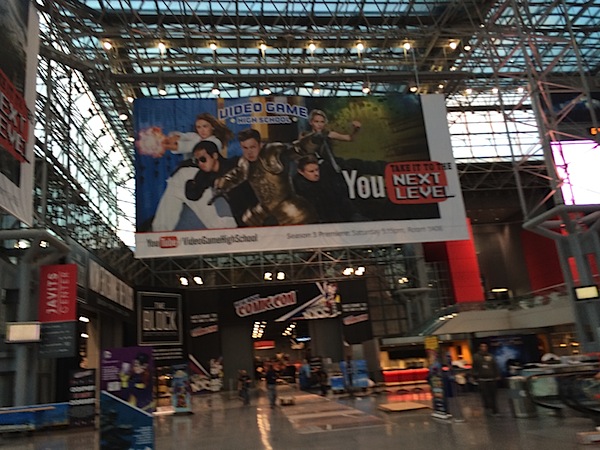
With all the comic cons and comic arts festivals going on, creators and exhibitors are becoming increasingly picky about what shows they go to. A lot of it is scheduling, but more and more what makes a good show is whether it’s profitable or not. You may recall the the Devastator and The Beat did a survey to get an idea of how and how much money people are making at shows. And of course there have been various arguments over whether cosplay, celebrities or hot dogs on a stick have more effect on poor sales at shows.
A few posts have been going around this week with concrete hints on how to exhibit. Tumblr’s Derpygurl chimes in with 25 Reasons Why You Don’t Make Any Money At Comic Cons and she wastes no time jumping right on why mumblecore and tabling don’t mix.
Keeping your head down at your table – I see rows of people with their heads down drawing instead of looking up and engaging the people walking by. (What? are we boring you?) Offer to give a custom drawing to someone AFTER they’ve bought something.
Not being able to describe your book or product – If you can’t describe your book in one sentence, you’re doing it wrong. If you are uncomfortable describing your work, find someone who isn’t and bring them (If you hate people, go back to your cave and sell your stuff online)
Not telling anyone where you are – 2 weeks before every con you should be on FB, Twitter and IG telling everyone what your row/booth number is. Make sure to include your twitter handle and the hashtag for the Con itself. Cons notoriously run out of maps and have bad wifi, leaving the masses to wander aimlessly. If your fans can’t find you, they will NOT buy from you.
…and so on for 22 more reality check type hints. I see people ignoring these 25 reasons all the time, and generally speaking, if you’re Adam Hughes or Kate Beaton, flout rules all you like. If you’re somewhere below them on the comics world food pyramid, you should read this post! The comments are equally full of hints, tips and tricks from the field.
Onrie Kompan came back with a post entitled 3 WAYS TO MAKE MONEY AT COMIC CONS, and he respond to Derpygurl with some Tony Robbins level motivational hints on standing up, engaging and so on.
Prior to doing a convention, go to one as a civilian and walk the floor. Observe what you think is done well and what you think could be done better. Talk to other artists. Many of them will be happy to share their experiences with you. Take their advice with a grain of salt and keep in mind that what applies to them may or may not apply to you.
Pay attention to both the good and bad things that artists are doing. Watch them sell. Take notes. Don’t skimp on a single detail. Look at other table setups and pay attention to how you want to display your work. A lot of what derpygurl said about what artists are lacking at cons is true. The more reconnaissance you do prior to setting up shop, the more confidence you will have when you open for business.
I will note that Kompan is known as a pretty vigorous salesman at shows, but that works for some people.
As some people point out in the comments at Derpygurl’s post, sometimes the reason you don’t sell any comics is because not because the show is crap, but because your comics are crap. Artist Alley is a pretty competitive place these days.
I’ve written before about what I call “Artist Alley Comics” — books published by small presses or self publishers that fit into the genre/Big Two mold and ape their appearance, as opposed to the more personal comics you’ll find at CAFs. Getting the word out about AA Comics is hard. Most of them are by people who aspire to work at the Big Two/Next Three and the material is often in “workshop stage.” Developing good exhibiting techniques and accepting honest feedback about work is often the key to moving on and up.
But then again, sometimes a con really is crap. Here’s Jade Woodruff on “The Worst Con in Florida” —perhaps a bit of an exaggeration but the first time Collective Con in Jacksonville, FL has a lot of first time show problems: lack of communication, lack of effective promotion, tables that were smaller than advertised, costs that aren’t in line with other regional shows, etc etc etc. Woodruff was also alarmed by an email from one of the promoters with important logistical information that urged exhibitors “don’t be an ass” while whining that he had to give up his Neutral Milk Hotel tickets to help with load in. I think you see the problem right there. Woodruff has quite an exhaustive account of what went wrong at Collective Con,
Vendors and artists hung out in the aisles, talking to each other. Some of the comic book guests were just as bored as I was. The comic guests left around noon on Sunday. Everyone seemed to share the same opinion: a two day show with lower costs would have been much better. We all thought that the advertising was there but that information was lacking which directly contributed to the problems we saw.
It was hard to say how many attendees were actually there. Given that all of the music festival was free to attend, I am skeptical whether the convention will provide total attendance numbers or paid attendance numbers. I’d be interested in hearing how many attendees were in each camp. It certainly didn’t feel like everyone came into the exhibit hall.
I never did find the advertised Beer Garden (or was it the truck outside?) or the Food Trucks that were advertised. I have yet to hear if any of the Steam Punk Demonstrations actually happened. I didn’t even know there were demonstrations because I couldn’t find that information on the website prior to the con and there was no brochure.
Yes, just another first time show that was a lot more work than the people running it thought it would be. She does note that another one of the promoters took the time to listen to her when she gave him her complaints, and to any prospective show runners out there, this could be the most important advice of all: LISTEN. Don’t get defensive, just acknowledge complaints even if they are just petty grousing, and learn from them. Nobody’s perfect, but a willingness to improve goes a long way.
Conventions are here to stay, and they can get messed up from any angle. If you’re running one or just exhibiting at one, do your homework, and try not to be the problem.
Blog: PW -The Beat (Login to Add to MyJacketFlap)
JacketFlap tags: Interviews, Image, Working for a Living, nate simpson, Top News, nonplayer, Add a tag
by Zachary Clemente
On the questionably damp morning of the last day of ECCC ’15, I caught up with Image creator Nate Simpson in a small breakfast place called The Crumpet Shop in Downtown Seattle’s world famous Pike Place market to talk about the second issue of Nonplayer, close enough to taste. The conversation spans his interest in narrative art, AI, and a discussion on creating comics in an rapidly gestating environment. Simpson is known for his work on Nonplayer, the first issue of which was release April, 2011. He lives in Seattle with his wife and young child and while he’s not working on game art, he wakes up at 3AM daily to turn out comics pages.
Nonplayer #2 is out from Image Comics on June 3rd.
[You’re joining us after a brief introduction.]
Comics Beat: Well, how about you? How did you get into comics?
Nate Simpson: Well, it was the X-Men; the late Chris Claremont era – Jim Lee, Marc Silvestri, and all that. Actually, right when I started getting out of comics was when all those guys were jumping ship to Image. Then I went off the college in ’93 and I didn’t really have much of an exposure to independent comics until art school six or seven years later.
CB: So you went to college then attended art school years later?
NS: Yeah, I went to college and totally got out of touch with comics completely. I went to the University of Chicago for Paleontology; there were not people reading comics, it was just not happening. After three years studying I realized I didn’t want to be a paleontologist – I just liked drawing dinosaurs. So I switched over to the Art Institute of Chicago…and that was just after Chris Ware had left. There was an indie comics culture there and I got into stuff like John Porcellino’s King Kat – that sort of stuff. From there I slowly worked my way back into comics through the indie angle, but I never really took it seriously as a career path until many, many years later. I fell into game art pretty much right out of art school and if you’re looking at it from a purely utilitarian standpoint – for an artist – there’s really no better game in town. It pays way better and it’s way more forgiving from a scheduling standpoint.
CB: There may be less pitching involved?
NS: Yeah, not at my level. So yeah, game art was going to be life until I came across this book of storyboards for Miyazaki movies – have you seen his original storyboards for Nausicaä?
CB: Oh, yeah.
NS: Dude, that shit melted my brain. It just the one guy working by himself with such a comprehensive vision and the final product was so similar to what his original vision was like.
CB: Did you see the documentary about him – The Kingdom of Dreams and Madness? It was filmed during the production of The Wind Rises and showed a lot of his storyboarding process. He uses a stopwatch while boarding to set the time of shots from the outset, so as each scene was set – he knew how long it would be. What’s really crazy is that the studio launches into production when he’s only half-way done with the script.
NS: That’s how assured he is – there’s no way to go back!
CB: That’s a really interesting place to come from, in my mind. When you mentioned that it was the Claremont X-Men and Liefeld posse were your earlier comic interested – I was going to say I don’t necessarily see those influences in your current work.
NS: Well, the one thing we overlooked is that is that I also had a major Moebius fetish. I think stylistically that’s more of where I’m coming from.
CB: That makes sense. I remember when I first saw the promo art featuring Elloden I thought that it looked very [Geof] Darrow – who’s a contemporary of Moebius.
NS: Oh yeah. I bought all three of the Hard Boiled issue when they came out, and they released like every year and a half – and I was so angry at him!
[Both Laugh]
NS: It’s so ironic. I was saying “what kind of asshole takes a year and a half?”
CB: These names remind me of an interview with Paul Pope I did right when the first volume of Battling Boy had come out where I asked him what he was reading. He said he was staying in his “fortress of influence” which was essentially Moebius, Toth, and Miyazaki.
It really excites me that as Western comics really finds its footing with its Eastern – mainly manga – influences, Miyazaki is beyond that. People were looking to him long ago, even though he hasn’t made a new comic in some time.
Getting back to it – would you say the Miyazaki influence is one of production or also stylistic?
NS: I would definitely say both, but it’s so hard to parse what part of each person you’re taking because it’s a very organic process. However, I was inspired in the wrong way by those storyboards because what I wanted to do was exactly that: make storyboards for a movie.
So the first thing I did was quit my job, which required a huge amount of patience from my wife who didn’t have a job at the time. We were just living off of savings as I was saying “I’m gonna express myself!”
It was a weird six or seven months of writing this screenplay and doing some storyboards for this big, grand, epic sci-fi space opera called “Gordon and the Star-Eater” and it was…horrible. It was the worst.
CB: Sounds like something I’d read.
NS: So after those six or seven months, I stepped back from the screenplay, read it again and went “this is complete shit.” I had wasted more than half a year, we’re out of money, and I had to figure out how to salvage this – make it worth leaving my job. I got super despondent about it and wrote about it on my blog; about how I was feeling lost. Although only three friends really read my blog, one of whom was a co-worker named Ray – who’s gone on to do concept art on Skyrim – told me to just draw a comic.
At the time I naively thought it was the simpler thing to do, rather than a screenplay and storyboard for a movie.
CB: And in many ways, it is. You don’t need cameras or intensely expensive equipment and software or a crew or anything like that.
NB: Exactly. It was very self-contained. I didn’t have to pitch it to anybody; I just had to do it and either it’s good or it’s not – it is what it is. I don’t know if you have something like this, but the “Star-Eater” project is something I’d been thinking about for around 15 years prior. I knew all the scenes, I knew everything that had to happen. It was so set in stone that there was no way for anything to mutate or grow; it was not a creative enterprise at all.
CB: That sounds like a dangerous thing to enter into.
NS: It really is. There was nothing there with that project; it was dead…it was taxidermied.
So that moment when Ray told me to do a comic I got, for the first time in many years, a blank slate to ask myself what I should do – and the story for Nonplayer came on the same day, all at once. “Here’s the stuff I’m interested in now and here’s the stuff I would have been writing about it wasn’t creatively constipated because of this other project.”
Writing out the script for Nonplayer happened really fast; the first two issues were written out in two weeks…and then it’s taken fucking five years to draw them.
CB: Something I’m curious about is your editing process. Given that much time between original script and final product, how many iterations or changes or evolutions have they gone through?
NS: Oh you have no idea; so many revisions. I save every iteration of the book. Some of the individual pages have up to 40 or 50 different versions from the very roughest thumbnail all the way [to final touches]. I’ve even made animated gifs of the process and it’s really cool to see stuff shift around, but the dialogue in changing with the art is changing and in some cases, entire scenes are added or removed – it’s a pretty fluid process.
That’s the great freedom and the great pitfall of working digitally is that you can continue to edit all the way through the process and what’s what I do: just keep polishing and polishing. If I were working in analog media, I would have erased through the page nine times, but there’s not common sense stopping point and that’s a long road that can really eat up your time.
CB: Would you say that the fact that you’re working digitally is enabling in that sense?
NS: Oh, absolutely. Here’s the thing though: without these tools […] I’ve been an adult for about 15 years before starting on Nonplayer and the thing that changed in my life that was enabling for Nonplayer to happen was the invention of the Cintiq.
I had tried to draw comics in pen and ink before and I found it so confining and difficult because I’d have second thoughts or would want to change something – it would drive me crazy. It was upsetting that I didn’t have the freedom to continuously modify. If I had been born 50 years earlier, I never would have attempted a comic, I would’ve lived and died having done some other thing.
CB: Proto game art?
NS: Yeah, maybe. I don’t know – I would’ve dug ditches or something. Maybe I would’ve been a paleontologist or a painter or something.
It’s sort of interesting, my training is in painting and drawing; there was a lot of oil painting. Once nice thing about that is that you keep working it – they even encourage you. I mean, some of those teachers work on one painting for 10-15 years; there’s not a time limit on a painting, you can build the paint out a foot deep if you want to. But that’s never really worked for comics, unless you’re doing painterly comics.
Comics as a pop medium is not an additive one; you need to have the idea and you need to get it out as cleanly and as quickly as you can; but these digital tools […] you have a clean end product but you work in a more painterly way, ironically. I sometimes redraw a line up to 50 times to get it just the way I want it!
CB: It’s so much easier to do that when you’re able to. It’s fascinating to think that we’ve hit a point technologically where it’s potentially as easy to edit the pages as it is to edit the script.
NS: That’s absolutely true. But here’s the other interesting thing: I think we’re in a weird time-gap where people who were trained to use analog materials, like me, have gotten access to these weird digital tools – so there’s a combination of ability and tools. But I notice that younger artists seem much more comfortable working quickly and iteratively – they just use the tools better than I do and they’re much faster than I am.
CB: While a bit reductive and not wholly true, something I do notice is a lot of artist I would consider your contemporaries only use digital for certain stages, like just for color and flatting or inking and up. But if you look at the “Tumblr generation” of artists, you see a swathe of amazing color sketches that were digital from the ground up and that’s all they work in. Sometimes you’ll see some of their analog work, but they’ve figured out how to fine tune the digital tools to fit their style that it becomes very cohesive.
NS: The end product is such a result of the tools, there’s no way to do what they do in any other way, whereas what I’m doing is kind of replicating what comics look like back when Moebius was doing them in the ‘70s. A better artist could do what I’m doing now digitally in an analog form. What I’m doing is “hacking my way” toward a finished product that has that level of polish, but I’m doing it sort of the hard way.
CB: Isn’t that the human condition?
NS: Yeah maybe – we’re all trying to rebuild what we saw when we were 13.
CB: That’s creation and memory. I’m fascinated by the idea of what it means to take something from here [motions to temple] and put it somewhere so other people can see it and how do your tools and the “you” of that time affect, muddle, or change the product. With digital, the opportunity is there to be as clear as possible is there, but it’s the tool could enable some distance or change from the original concept.
Reminds me of Nick Drogotta who, up until issue 15 of East of West was working exclusively digital, but people kept asking for original pages so he switched to penciling on paper to accommodate.
NS: Yeah, and there are guys who do the opposite too, right? There are guys who pencil digitally, then ink on printed out pages. I guess you could do it either way.
Do you know who William Stout is?
CB: No, I do not.
NS: He’s an artist who was predominate in the ’70s – I think he did a bunch of Conan stuff and also a bunch of dinosaur drawings that I got super obsessed with. But seeing his work in person, which I have a couple times, he’s the example the resonated the most for me. There’s something about seeing it on the page; the way that the inks and watercolor […] it was like looking at a jewel. I’d seen them in reproduction and thought they were beautiful but seeing them in real life I understood. It has to be made that way because the important thing is not the reproduction – the important thing is this real object.
And certainly the ethos behind Nonplayer from the very beginning was the only thing that’s important is the book at the end – everything is aimed in that direction and there’s no “object”. There’s a part of me that really wants to make the object; there’s a part of me that’d love to have the freedom to take a step away from the way I’m doing things with Nonplayer and try a different approach. Maybe on another book or whatever, because those are skills that I have.
That’s another thing that doesn’t get talked about very much; it’s that people see the way that Nonplayer gets made and they think it’s the way I draw – “this is the only way he draws”. They think I’m a slow, meticulous artist who works digitally and nothing else because they’ve never seen anything else that I’ve done. I think there’s a little bit of selection bias or something happening there where the only reason they’ve heard of me is because that was only book I made that caught peoples’ attention. For instance, as a game artist, I have to work very quickly, very iteratively, and very roughly sometimes.
CB: It’s a very small sample to base an opinion off of.
NS: Because that first comic was made at the level of polish it had, all of the others will be have equal to or better than the first one. The second one, by at least some measures, is better. So in a way, I’m locked into that and it’s a pretty rough thing to be locked into. I love working on it, but as an economic proposition, it doesn’t make any sense at all. It doesn’t come close to paying for itself which is why I work on it from the hours of 3AM to 6AM every morning; I have to have a job and a life outside of it.
Sometimes I ask myself if the first comic I had made had been rough, gestural, and quick, it theoretically could have been more financially sustainable, maybe. But would it have gotten anyone’s attention? I might not have, that might not be what people were picking up.
CB: It’s that weird strongly-held belief that artists can only do one style where whatever their working on the time is likely influencing how they draw it. I personally would hazard that most artists at DC and Marvel have the potential for artistic fluidity, but they are working towards specific, recognizable style. Take a look at one of my favorite cartoonists, Boulet – he is able to do so many different kinds of work.
NS: Oh yeah, Moebius was a master of that too, he was all over the place.
CB: Definitely, but his work is always recognizable – I feel he kind of transcended shifts in style.
NS: He was so prolific that if he made something people thought was shitty, the next day he’d make 10 other things.
CB: His speed definitely helped.
NS: This touches on the hot-button topic with issue two coming out; I think there’s a certain amount of…wariness. There’s a certain kind of person who feels like I’ve cheated them in some way and here’s a part of me – a voice inside – that agrees with them. There’s always that little voice inside of me that’s always frustrated with how long this is taking. “Who do I think I am? Who else gets to come out with a #2 four years later and have the temerity to ask people to pay attention to it?” I should be skulking in the darkness, meekly handing it out and scuttle away. But because I’ve put so much time into it, because I’ve been thinking about this for so long, I have no choice but to promote it as hard as I can.
But there are a lot of people who are telling me that everyone else does 12 of these a year and I do 1/48th of one.
CB: I would maybe say that’s a product of, realistically many things but, the oppressive nature of the direct market and the hilarious difference in “creation time” vs “read time”.
NS: We have such a “box office mojo” obsessed culture that we’re having trouble separating the question of comics as an economic engine and a question of comics as a creative pursuit. Making a comic this slowly is a completely losing proposition economically, both for me personally as a creator […] I guess Image makes a little money off of it but it’s barely worth their time. It really doesn’t do much for the retailers – it really doesn’t do much for anybody from a monetary standpoint.
But I’m still doing it in my spare time. It’s getting done. There are gonna be seven of them, two down, 5 to go. I would love to go faster and I would like to find a way to work on this full time and there are some discussion going on about that, but I doubt it’ll ever be financially self-sustaining. It’s just not how it’s gonna go. Does that make it less valid from an artistic standpoint? Assuming this all gets done, assuming I don’t get hit by an asteroid or something, it’ll get done eventually. And when it’s done, it’ll be collected in trade – that big, polished, finished thing – will people factor in the time it took to make it when they make a decision about whether or not they want to buy it? Or, more importantly, when they’re deciding whether or not it’s a good book?
I’m deep in the shit right now, so it’s hard for me to even think that far ahead. I have to remind myself of this every morning at 3AM. “This is worth it because it’s gonna be good in the end.”
CB: That raises an interesting question about the worth of artistic agency. How much is your project “worth” to somebody? I think you’re maybe missing the direction comics can go – for a long time they were driven by the big two, but as other publishers get more of that market share and pushing to have good comics available for every reader possible, you start seeing other shifts.
For instance, Brandon Graham works on a lot of stuff so his solo projects like Multiple Warheads are produced pretty slowly and he shrugs off people giving him flak for it. Of course, he seems to be in a situation where that works for him; having enough going on for it to be okay.
NS: He’s very self-contained, very charismatic, and doesn’t need anybody’s love.
CB: He doesn’t need anyone’s validation, he don’t need no man.
NS: Yeah, exactly. It just occurred to me […] I sometimes feel sorry for myself – as do others – over how I just can’t get all the time I need to be able to work on this all the time, and that would be great if that happened. But, in a weird way, the fact that this comic is not my sole source of income gives me much less freedom on the time axis, but a huge amount of freedom on the quality axis that full-time comics artists don’t have because if next month’s rent depends on you getting this book out the door, that’s going to be controlling your artistic decisions. So in a weird way, I have maximum freedom. Especially with the advances in medicine, I don’t have to worry about dying of old age then, you know, I can just keep this going! So it’s both a blessing and a curse.
CB: Something I’m interested in with Nonplayer, from a storytelling perspective is this idea of the hyper-real where you have a possible near future version of our world but within it is still the need for fantasy. I’m curious about this idea of meta-escapism; do you think this kind of story could have been as easily discussed if not for online gaming?
NS: Yeah – it definitely wouldn’t be the same story if there weren’t MMOs. One thing you’ll see in issue two is some of the new characters are the developers that are building that virtual world. So the choice of doing an online game came at least partly from having worked in games; the personalities involved in that whole thing but I think if we somehow managed to skip online gaming and went straight to the metaverse or some sort of cyberpunk version of what the online world is supposed to look like – I think the story would not be the same. The core conceit of the story is that there are two worlds that are, from an atmospheric perspective, very different from one another, but equal.
Jarvath and near-future Los Angeles, in the structure of Nonplayer are completely equal – neither one is more real than the other. That’s just the core conceit of the story.
[Interviewer note: Nate and I discussed some concepts that crop up in parts of Nonplayer that aren’t out yet and have been omitted from the transcription.]
CB: It sounds like from this and for previous interviews that you have a huge interest in AI and it sounds like that makes its way into Nonplayer.
NS: Oh yeah, there’s this book called Superintelligence by Nick Bostrom that I recommend to everyone. It’s a little dry at the beginning, but then you get into the 100 pages and, well, my brain has exploded so many times reading this book. Broadly speaking, there are two “kinds” of AI that he thinks we may end up developing. One is essentially a human-equivalent AI that is probably developed as a result of us trying to model the way a real human brain works and then evolve it from there.
CB: That makes sense – it’s the only real sentient option we have to currently base off of as we know it.
NS: Right, there is one living template that we can attempt to replicate and yeah, that work is ongoing. We are scanning human brains and attempting to recreate them in a digital matrix: that will happen. However, there are all these other – to my mind more interesting but scarier – things happening where there are forms of essentially alien intelligence that may or may not be evolving and even improving themselves over time and their resemblance to our consciousness is as distant as ours is from an ant. So there’s the potential for these immense intelligences that have nothing in common with us that could be unfathomably dangerous to the existence of humankind. That’s what they [Bostrom] talk about when they talk about the “singularity” – that sort of intelligence having an efflorescence.
Nonplayer has both. In the second issue, I introduce another AI character which is working for this regulatory bureau which is one of the latter category – it’s an alien intelligence that is unbounded in its power, but it’s kept in a cage; a god in a cage whose entire function it to monitor the internet and catch other AIs that are loose. I also have the first kind running so I get to play around with both kinds and I don’t have to pick sides; I can just explore all of it.
To answer your question: AI is of interest to me, yes.
CB: I think this links back nicely to how you earlier said that you were “constipated” while trying to create. This looks like a great example of allowing your work to be dated to a specific set of interests and influences you are having during the process of the work; not to make work in a vacuum.
NS: Yeah, absolutely. Also, when people write AIs now, especially for movies, it’s always a monster. It’s always basically a mean human with some extra power. I feel like an honest depiction of a malevolent AI would be so much more deeply horrifying because it’s less like a human and more like a spider or something. I don’t even think it’d be capable of malevolence, specifically because I don’t think it’s going to care about us.
CB: Right, does our potentially limited palette of emotional or social queues even apply to an intelligence that is extremely not human in nature?
NS: I don’t even know if you get to use the work “nature” and that’s where it gets really interesting. We’ll find out if we’re even compatible in 20 to 30 years and I hope it works out for us.
I hope the AI likes Nonplayer. They very well may be the only things to read the final issue.
[Interviewer’s Note: I spend more time than is worth transcribing telling Nate about Jonathan Luna and Sarah Vaughn’s Alex + Ada – another fantastic Image title involving AI sentience.]
NS: You know, one thing I like about Eric [Stephenson] is that he really has the patience to let a book unfold, even if some books don’t perform that well in issue format, but once they’re collected they can be great.
CB: Yeah, having that be an option in a system that demands certain things upon stories based on a very tight schedule is nice.
NS: Woe betide the person who has a story that doesn’t fit neatly into the structures that are currently in place.
CB: And inside this structure, it looks like Nonplayer occupies this unique role of the Pariah almost, in certain circles of comics readership.
NS: It’s a target, for sure.
CB: Do you think with the changing climate of comics creation, would this sort of reaction happen again?
NS: I think people are looking at it and consciously or unconsciously, they’re recognizing that it’s economically stupid. Maybe we’re part of a culture that places a lot of emphasis on that, right? Why do we care so much about how much a movie makes on its opening weekend? How is that relevant to anything? I see how it’s relevant to the people who made it, but I don’t see how it should affect what I feel about the movie, but people like to crow over the dead bodies about a failed movie.
I feel there’s a similar impulse with Nonplayer where there’s a little bit of schadenfreude where people just like to see a ship go down. Yeah, I think some people decided that I was lazy; there’s definitely a narrative of laziness there, but I’ve never stopped working on it or maybe I don’t know what the definition of lazy is.
CB: It’s interesting how those narratives around creators get formed. I feel like it was different when it was only letters sections, conventions, and signings, but now everyone has a blog, mailing list, or twitter account to work with.
NS: That’s actually the one thing that saved my bacon; if my book came out in a vacuum – if it just hit the stands one day and no one had any idea who I was, I think it would have vanished immediately. There’s the narrative of the book, but there’s also the narrative of the creation of the book and if I’m being honest I think that most of the people who are supporting Nonplayer are, on some level, supporting the enterprise as much as they’re supporting the book itself. They understand how painful it was to make it and I find, in a lot of cases, that there are people with similar ambitions or projects who empathize with the difficulty of the project.
So, for everyone person who casually shits on the book in a comment thread on Newsarama, there are a lot of people out there who either read my blog or whatever that understand what it is that I’m trying to do and are much more forgiving.
CB: Do you think we’re approaching an era more based around creative compassion?
NS: I hope we are! There is the existence of all these crowd-funding stuff so a lot of people keep coming to me to put Nonplayer on Kickstarter or Patreon since it’s not sustainable in the comics market. They ask me why I shouldn’t try to find a way for people to give me their money directly.
Well I have a little experience with Kickstarer through games; if there’s a target on me now, you cannot imagine the size of the target that would be on if I were running a Kickstarter. “Now look at this guy! This lazy ass is coming out, hat in hand, asking for your money directly.”
CB: Do you think that’s a good reason not to do one?
NS: I think it’s actually a bad reason not to do it, but I am definitely conscious of having a target on my back and to ignore that requires maybe more self-confidence than I personally have. Also I don’t know what it would be that I would offer through a Kickstarter – I already sell posters and whatnot. I’m not even sure that having a successful Kickstarter campaign would allow me to work on the book full-time anyway.
Either way, as weird a book as Nonplayer is, there’s no other place and no other time that it could have become a real comic. Eric…really rolled the dice on it.
CB: I’m curious how that happened, how did Nonplayer find its way to Image?
NS: Joe Keatinge. I was posting these pages to my blog that three people read and one day I sent a fan letter to Brandon Graham. I’ve always been a fan of his and sent him a link to some of the images on my blog to show what I was working on. He posted a couple of his images and the day after that Warren Ellis, who apparently read’s Graham’s blog, posted a couple images from it and all of a sudden I had three readers to 3,000 in a week. The internet really make this thing happen. I don’t really remember the whole mechanism, but then I began interacting more frequently with that group of Image creators including Brandon and Justin “Moritat” Norman. Joe was a part of that circle, he was working at Image and he was a big fan of the book and pitched it to Eric on multiple occasions and finally Eric said “well sure, let’s put it out.”
I’m certain he couldn’t have anticipated how long it would take me to get out the second issue, but he knew it wasn’t gonna be monthly. I’m sure he would prefer the book to come out a lot faster than it has because we have to climb a completely new promotional mountain for every one of these issues because there’s no momentum at all. But he stands by the book and he likes the book, I don’t know many other publishers who would be okay with that release cadence.
Even if Nonplayer is never successful financially, I think it’s successful because I’m proud of it. It could sell two copies and I’d still be proud of it.
CB: Yeah, Image is in a really unique gestating place where it’s trying out all kinds of new stuff and who knows where they’ll be in five years.
NS: I don’t know how true these things are because I didn’t hear them directly from the horse’s mouth, but some of the people who have been associated with some of the more recent big successes at Image like Saga or Shutter […] I’ve been hearing that they were “somewhat inspired” to do the projects that they decided to do because of Nonplayer. Obviously their books are coming out monthly so they’ve got something I don’t, but if it’s true, that’s very gratifying. Maybe it served that purpose; to shake something loose or open up a possibility just a little bit in a new direction.
I’ve talked to two or three pretty prominent female artists who weren’t active in 2011 or 2012 who are now a really big deal, and Nonplayer was very high on their list of things that got them excited about what comics could be.
CB: I find that a really great thing and sort of brings me to my last question that we didn’t touch on by accident. Many years from now, when you get your comps of the nice, assuming hardcover of the collected Nonplayer, do you have plans of what’s next?
NS: What’s a good intersection to commit seppuku?
I have another project that I’m writing that I expect someone else to draw and I’m very excited about it. That’s another strategy I’m exploring to make it so I can work on comics full-time. If I’m a writer on a book, that takes up two days a week and I can spend four days a week on Nonplayer, which will speed that up immensely. The question, of course, is there any universe where writing a book and drawing another slow book brings in an amount of money similar to what you make in games? The answer’s probably no, but we’ll see.
CB: That’ll be an interesting test of faith to see if people who feel burned on Nonplayer will be willing to pick up a book you’re on.
NS: Yeah, I’d have to have multiple issues in the can before we even pull the trigger and it would have to be a bunch of proven artists, probably multiple artists similar to the way Brandon did Prophet. Many people predict retailer gloom and doom saying no retailer will ever trust me again and all that, but my personal experience has been the opposite. Retailers have really liked Nonplayer, it’s an easy hand sell and they just want more of it, so that’s a good problem to have.
CB: As readership changes, so do the shops, it seems.
NS: Yeah! I love where comic shops are headed. They’re not these back-alley, heavy metal places anymore. They’re getting a lot friendlier, especially to female readers. I may be benefiting on some level from the shift in demographics, my comic is a little more accessible than what was being made when it first came out – now everything’s so much broader. Frankly, Image has been the biggest beneficiary, just look at their market share, it’s crazy.
CB: Thank you very much for your time, Nate.
NS: Thank you.
 Nonplayer #2 (APR150542) will be available on JUNE 3RD and can be pre-ordered now.
Nonplayer #2 (APR150542) will be available on JUNE 3RD and can be pre-ordered now.
Blog: PW -The Beat (Login to Add to MyJacketFlap)
JacketFlap tags: gabo, matt chats, Interviews, Comics, Oni, jupiter, Kickstarter, Oni Press, Working for a Living, Top News, Crowdfunding, micro-fiction, Add a tag
Welcome to MATT CHATS, a weekly interview series in which I talk to a creator, consumer or seller of comics. This week I spoke with Gabriel “Gabo” Bautista, who is working on several projects right now including The Life After for Oni Press and Albert the Alien for Thrillbent. During that time he also managed to fit in Jupiter, a series of 100 micro-stories set on the largest planet made up of just one drawing and one page of text each. His Kickstarter campaign has been funded, but it’s still running so you can jump in and get an early copy of the hardcover and push it closer to its stretch goals. I spoke to Gabo about creating Jupiter, setting rewards for the campaign and more.
I first encountered your work with The Life After, and what immediately struck me was the panel density. What was your reaction to a script that asks for a lot of panels per page?
I’ve always been a fan of using a lot of panels! The idea of slowing down time by shoving more panels on a page has always intrigued me, so when I first read Fialkov’s script I was elated. There is that 50 panel two-page spread that we had in the first issue. The monotony and slight repetition of each panel really drives home the idea that Jude does the same damn thing day in day out, like many of us have suffered or currently suffer in our day to day lives. I’m all for a page full of panels as long as there is a good reason for it!
Did working in that kind of style influence the creation or development of Jupiter?
Jupiter was mainly influenced by two things: a challenge by Kenneth Rocafort to do a daily drawing in a Moleskine daily planner, and constant dreams of futuristic settings that I feel intimately connected to. The rest sort of just ran its course on its own, I just sat back and let my hands do the work.
What’s the appeal of a story told in one image and a page or less of text?
I’ve always been intrigued by the synopsis’ you find on the back of books, especially sci-fi and fantasy novels with those amazing painted covers. Being able to squeeze a whole concept into just a paragraph is the idea I wanted to harness for this project. The fact that you can open the book to any page and be immersed into that world for a brief moment is what I find appealing. That and it’s great for people like me who has short attention spans haha.
Do you find micro-stories to be more or less challenging than longer-form projects? Why?
I’ve never taken on the task of writing something longer than a few pages, but I feel micro-stories are easier in that it doesn’t take a lot to belt one out, its almost like playing a quick game of poker vs a round of Magic the Gathering. While Magic is way more complicated and requires more time to complete, poker in itself is full of strategy and complications that take years to master, only its much faster to play.
For me, developing a story comes pretty easy. Sometimes I feel that perhaps my brain produces way too much of whatever chemical causes someone to make things up, but I sure as hell am grateful for it.
Is there any way you’d prefer Jupiter to be read? All at once/one at a time/some other way?
I’ve never really given that idea any thought. I suppose it could be read from beginning to end, but at the same time I love that Jupiter is like a sketchbook where you can flip to any page and be sucked into that scene in just a matter of seconds.
Would you ever sell the Moleskin daily planner that contains all of the Jupiter drawings?
I’ve had a lot of friends suggest I put it up as one of the reward tiers, putting a price of a couple thousand on it, hoping maybe some crazy rich person would pledge for it. At the same time though I’ve had other friends who scold me for thinking about it, saying I should keep it as long as I can. I’ve never been big on keeping my art, hell sometimes I just give it away at conventions, but the idea of giving away or selling a book with over 100 drawings in it is a bit hard to process. To be honest my biggest fear would be that the pages would get separated and distributed, and at the same time I would love nothing more than for people to have a little piece of Jupiter to themselves. I’M TORN. WHAT DO I DO? It’s literally just collecting dust in my studio! [Laughs] Maybe in a few years I’ll start tearing out the pages and gifting them or selling them. WHO KNOWS. I have to keep reminding myself that we are simply guardians of art until a new owner is found.
You offer high-level of backers a significant influence over the content of your book, particularly at the $250 level. Was that an easy decision to make, or did it feel more like a necessary evil in order to get funded?
It was 10% “necessary evil so I could get funded.” I figured people would be clamoring at the chance to be in the book. “TO BE IMMORTALIZED,” I kept repeating in my head. Overtime though, I’ve realized that the people who becoming part of the book WILL be immortalized, in my heart. Cheesy, ain’t it? I’m serious though! Those people who pledge at that level believe me and Jupiter enough to become a part of it, they trust in me to do a great job in taking their likeness and converting them into a legend of Jupiter. It’s super awesome, and they are super awesome. Ultimately though, I always wanted to have this be a THING in Jupiter, taking a few people and turning them into legends… It’s neat!
After 100 drawings and 100 stories, how connected are you to this world?
There’s a lot of it that I don’t remember. I look at the images and fragments of the stories come to me. Sort of like when you’re looking at an old photo of yourself hanging with friends. You might know when it was taken, what might have been going on in your life then, but you probably don’t remember it as well as you’d like. My connection to the world of Jupiter I’ve created is similar; I don’t try to force things into it. Instead I let those things come out when they want, and hope to hell they make sense and that I can jot them down before I forget them.
What’s the scariest part of the project for you?
The scariest thing for me was not being able to fund it. After Day 2 of the Kickstarter, the fear was completely obliterated.
Now that the campaign is funded, are you thinking ahead about future stories?
I’ve been planning this for a while; the illustrations in Jupiter are actually from a 2013 Moleskine daily planner. I’ve got a 2014 thats nearly half full, and a 2015 that I’m currently filling. The next book will be slightly different, though; some of the stories will be written by guest writers (some of which will be some notable comics people!) I’m looking forward to seeing what people write to a piece of art that’s already been created.
Jupiter is just one of many projects you’re working on. How do you balance it all?
I have no damn idea. I can’t deny that I’m late on some projects and have had to pretty much cancel or put other projects on hold, but Jupiter has been done for several months, and I just needed to get it out of my system.
What keeps you cranking out pages, day after day after day?
BILLS, MAN. BILLS. I literally have no choice, if I slow down or slack off I will be sleeping on the streets. No greater motivator than the risk of going homeless if you goof off too much. Also the fact that I’m getting old. I see all these young cats in the comic game making power moves, and I’ve just barely reached the big leagues at 34? I don’t have time to mess around, I need to keep moving, keep drawing. Draw or Die.
You can find Gabo on his website and on Twitter, and back his Kickstarter campaign for Jupiter for a few more days. Don’t wait.
Blog: PW -The Beat (Login to Add to MyJacketFlap)
JacketFlap tags: Working for a Living, Top News, Add a tag
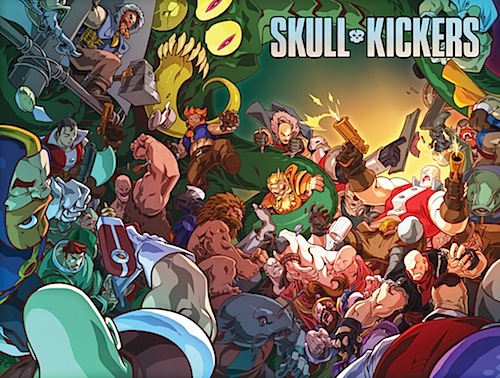
For some reason, this post from two years ago, Creator says creator-owned comics pay as little as $31.25 a page—if you’re lucky went mildly viral on FB over the last few days. It refers to THIS post by Jim Zub where he laid out the economics of an Image Comic:
Printing varies wildly, but let’s say 80 cents per issue holds true. With the remaining 30 cents per issue, the following has to be paid: • Advertising/promotion. • Publisher operation/office expenses. • Money left over for the creative team to actually get paid anything. • Profit?
On a print run of 5000 comics (and many, many creator-owned titles sell less than that in the current market), it means $1500 remains for those 4 important categories. Guess how that breaks down?
If the advertising cost was ZERO and publisher expenses were ZERO, then the writer and artist of a 20 page comic would each get $37.50 PER PAGE. Oops, no money in there for the cover art, sorry. Add in more people (inker, colorist, letterer, etc) and the amount gets split even further, but this is a BOGUS number. The publisher has expenses/staff to pay for.
While I have no doubt that the numbers are still relevant, I feel that two years later, the rise of Image Comics in general should be noted. The December sales chart shows the #300 book selling just a shade OVER 5000 copies. To pick a random book, The Wicked and the Divine #6 sold 22,159 copies or so. Of course, Gillen and McKelvie have come a long way since the single can of tuna days of Phonogram, but Image Comics are HOT. Readers check out the latest books as they would the latest Big Two titles, and a lot more are selling over the break even point than ever before. Skullkickers may have reached it’s “Standard attrition” level, but Zub’s new book, Wayward, sold 10,009 of issue #5.
I’m sure Jim Zub will be along in the comments with his own observations, and like I said, there’s still a lot of Kraft macaroni and cheese to be eaten before—IF—you get to add some pancetta to the dish, but the market has changed a LOT since that post was written, and I wanted to point that out.
Blog: PW -The Beat (Login to Add to MyJacketFlap)
JacketFlap tags: Cartoonists, Working for a Living, Top News, Add a tag

On his Tumblr, Brian Micheal Bendis was asked about why he’s stayed with Marvel when so many others have gone 100% creator owned.
Seems like most of the guys from your generation (Fraction, Brubaker, Millar) made a name doing their own stuff, built up a name at one of the big 2, then left to do their own stuff but with a bigger following. What makes you stay on at Marvel? Do you think you always had different goals from the start?
and he pointed out some very good reasons to stay:
Everyone to their own path.
but it’s weird that I keep being labeled, by some, as just marvel dude because I do produce as much if not more creator owned work as everybody else doing creator owned work. in fact with the powers TV show just a few weeks away I am as involved in the benefits of creator owned then just about anybody on the planet aside from Robert Kirkman. it just so happens that Marvel is also my home for creator owned work and have been publishing powers for over a decade
but why Marvel? I absolutely love it. I feel an immense honor being one of the caretakers of these characters that mean so much to so many. my kids are little and all of their friends love the guardians or the avengers and the thrill they feel when they find out I’m somewhat involved is very inspiring. I am afforded a great deal of freedom to express myself in characters that mean the world to so many.
so I get the best of both worlds. why wouldn’t I do both?
You know, there’s nothing wrong with sticking with a job you love, especially when you have a “TV” show coming out that will potentially rewards the fruits of creator-owned labor over many years. Bendis has had one of the most successful careers in comics history, ad having choices is what helped make it so.
View Next 25 Posts



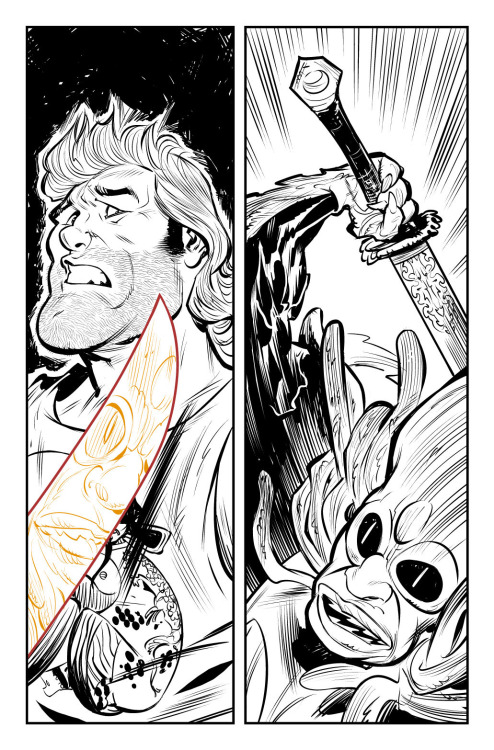

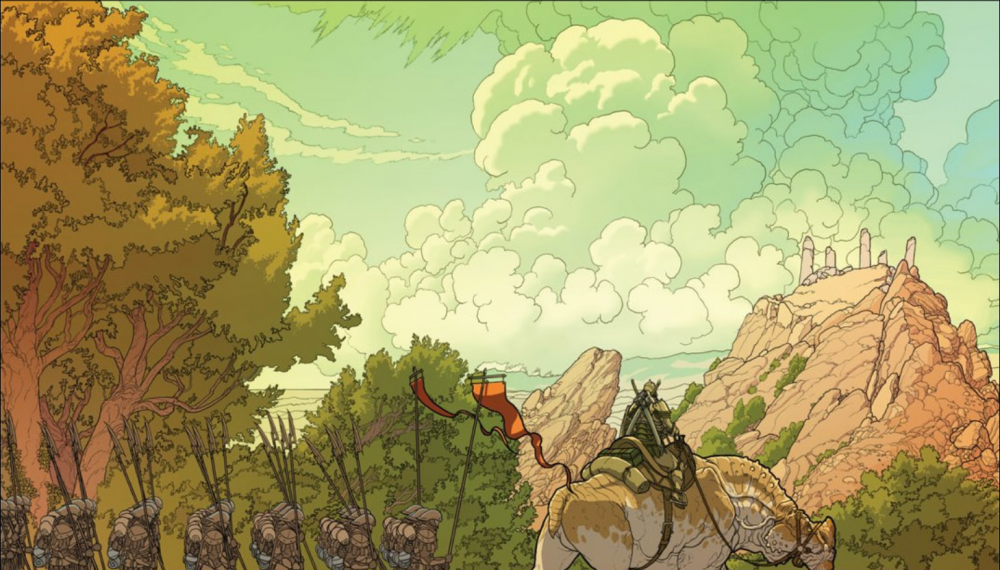
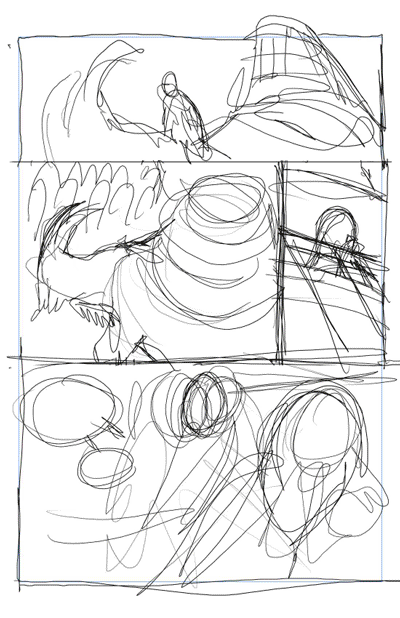
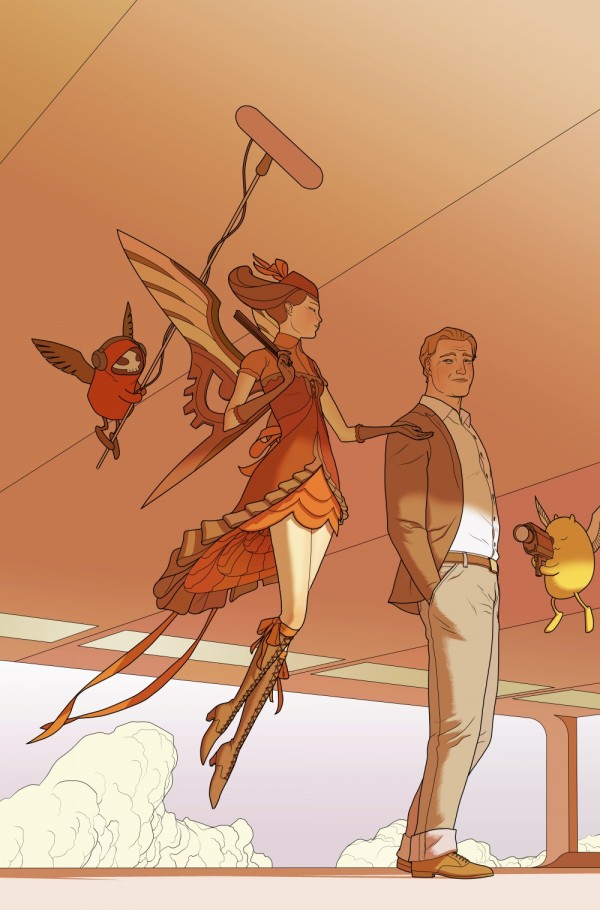
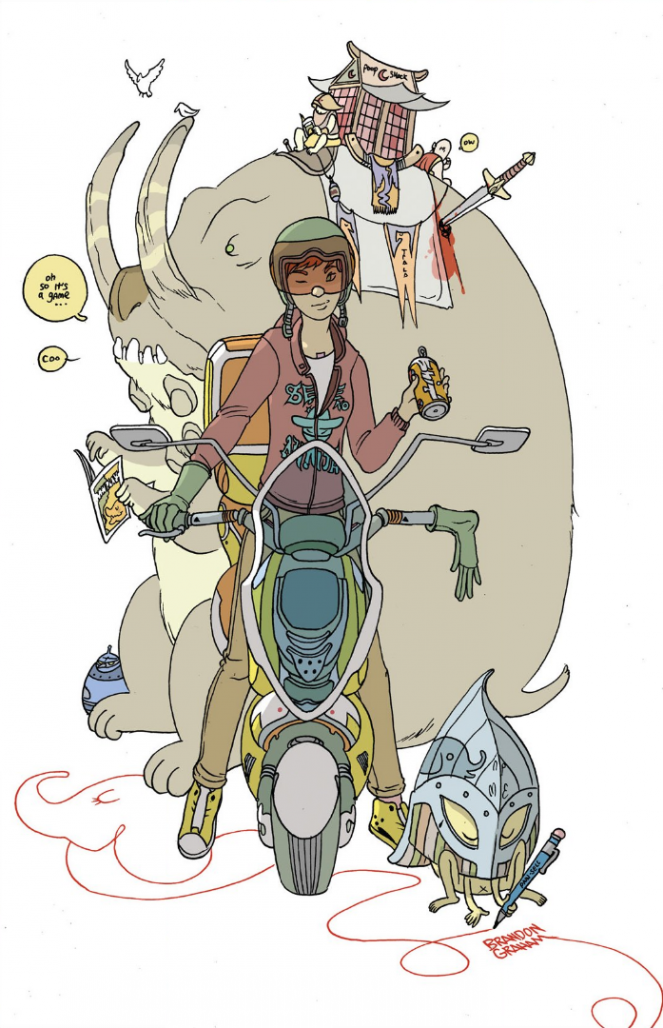
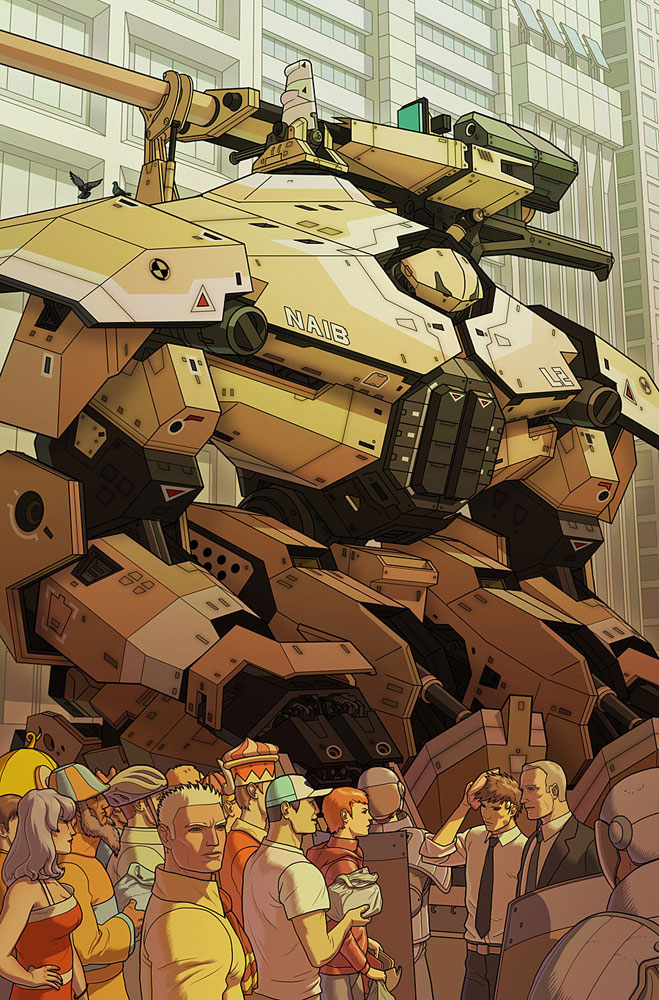
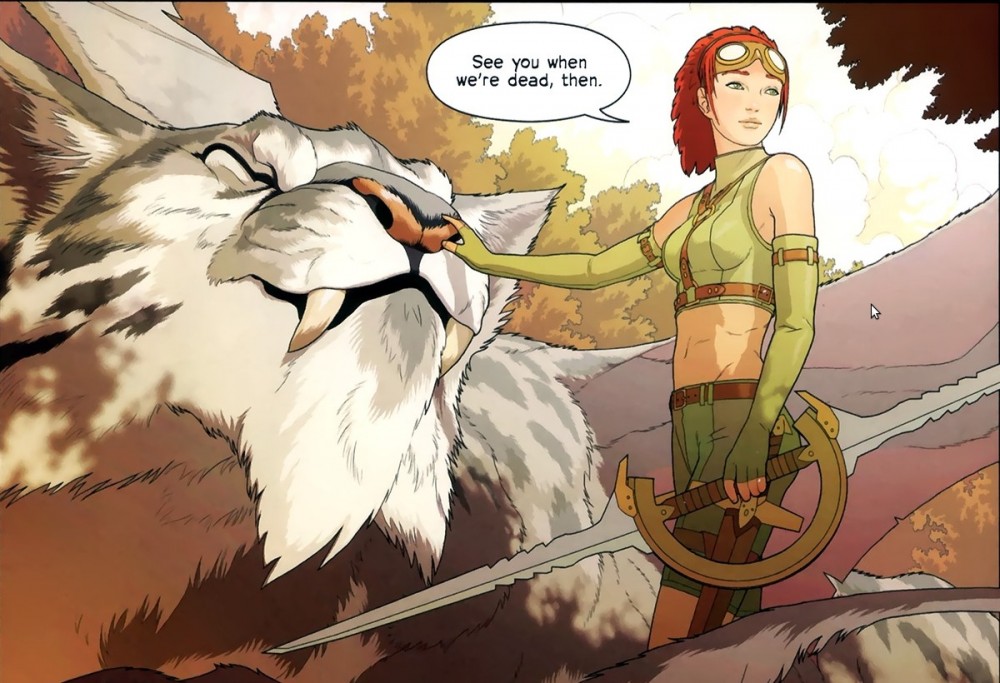
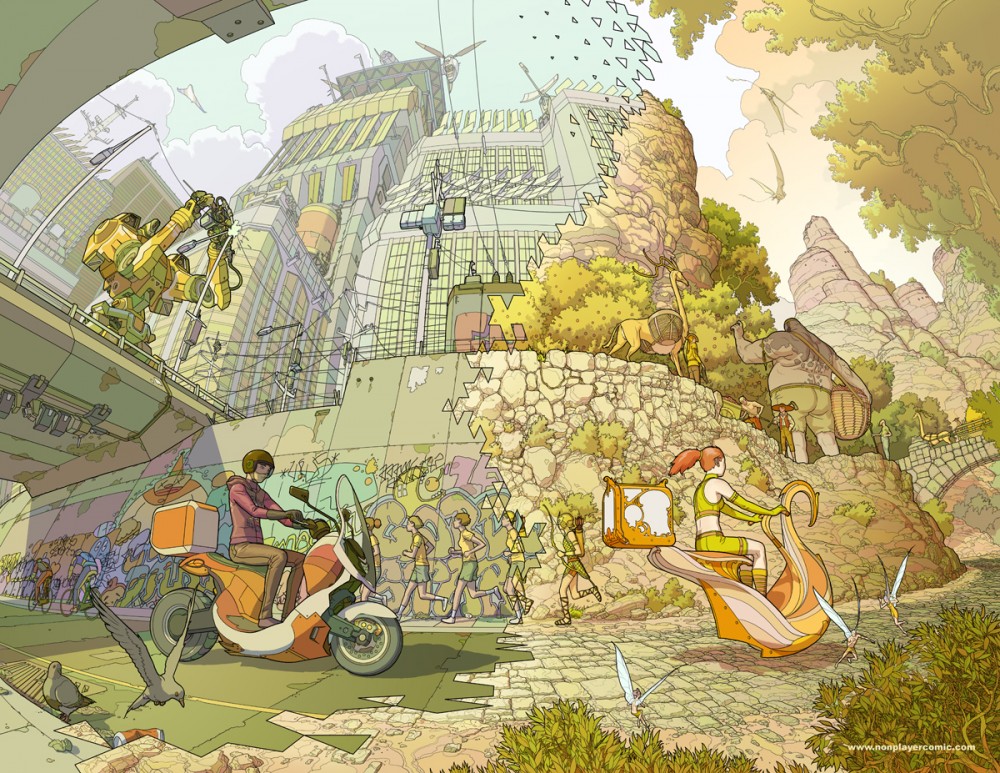



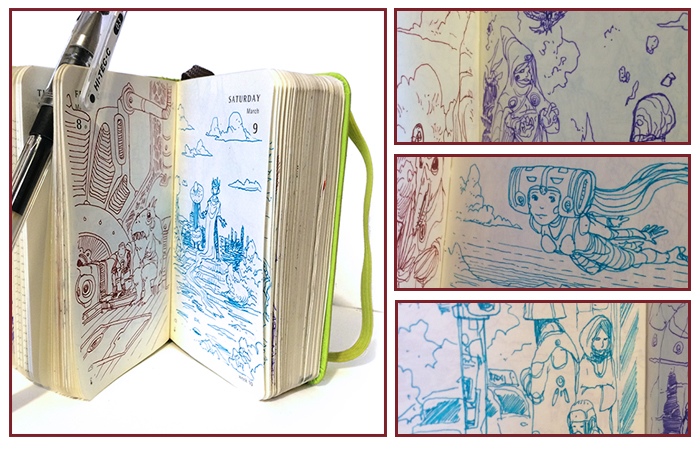


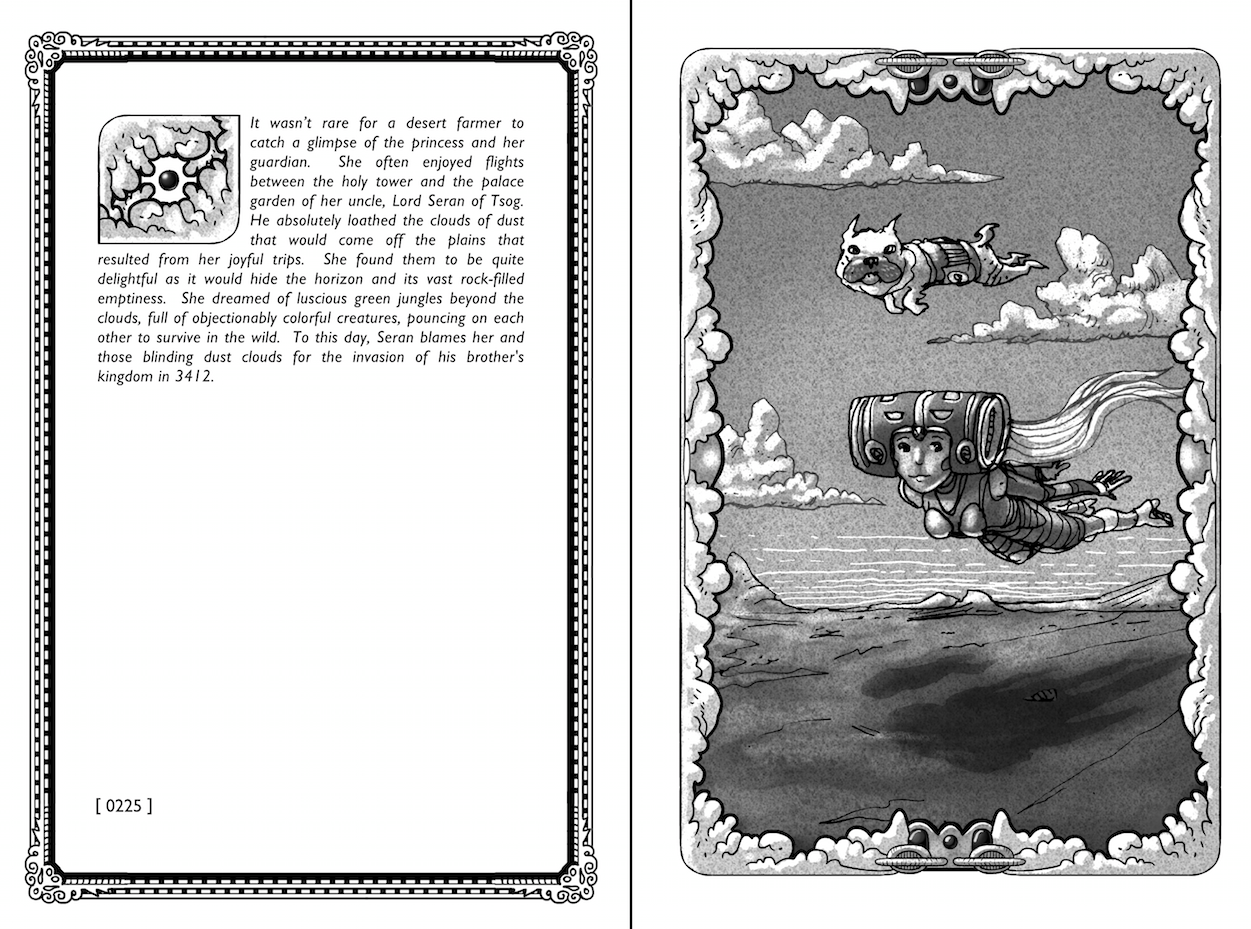


I wasn’t aware that DC was “scouting” people for its talent workshops. That alone raises many questions.